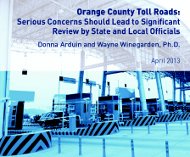Article from: www.thenewspaper.com/news/40/4074.asp
4/12/2013
California: Toll Roads Generate $1.7 Billion In Red Ink
Analysis shows two Southern California toll roads were unsustainable from the very beginning.
 The debt load accumulated by the toll roads in Orange County, California is unsustainable, according to a study released Tuesday by the Pacific Research Institute. Researchers Donna Arduin, former budget director for California Governor Arnold Schwarzenegger (R) and Wayne Winegarden, a senior fellow at PRI, examined the financial status of the publicly owned Foothill-Eastern Transportation Corridor Agency's 241 toll road and the San Joaquin Hills Transportation Corridor Agency's 73 toll road.
The debt load accumulated by the toll roads in Orange County, California is unsustainable, according to a study released Tuesday by the Pacific Research Institute. Researchers Donna Arduin, former budget director for California Governor Arnold Schwarzenegger (R) and Wayne Winegarden, a senior fellow at PRI, examined the financial status of the publicly owned Foothill-Eastern Transportation Corridor Agency's 241 toll road and the San Joaquin Hills Transportation Corridor Agency's 73 toll road.
Advocates insist tolling is a superior transportation funding mechanism because it is based on the concept of "user fees" -- those who use the toll road are the ones who pay for it. This concept has gone out the window with the Transportation Corridor Agency (TCA) toll roads, which the report found use an estimated $1.7 billion in taxpayer subsidies. Worse, the roads are deeply in debt.
"Based on our review, the operations of these toll roads presently appear to be unsustainable and likely have been unworkable from their inception," Arduin and Winegarden wrote. "The original financial plans for the 241 and 73 toll roads were based on overly optimistic growth assumptions and did not leave a financial cushion for TCA to operate under reduced utilization or economic downturns. Subsequent decisions by TCA board members and managers have made matters worse."
In the 1970s, the state planned on building State Routes 241 and 73 as normal, gas-tax funded freeways. Around 1984, however, the tolling fad began to take hold of transportation planners, and local officials decided to create the public "joint-powers agencies" that is supposed to run the road as a toll road until the bonds are paid off in 2035, though that date has since been pushed back to 2042.
The report found that the toll roads have been unable to pay their debt obligations since 2006. Initially, the roads were to cost $858 million to construct. The actual debt load is now $4.4 billion, with debt payments totaling $11 billion over time. The primary culprit is the lack of use of the roads. Traffic on the 241 was only 65 percent of the projected level last year, and the 73 only saw 42 percent of the projected value. San Joaquin Hills Transportation Corridor Agency has a junk bond rating, while the Foothill-Eastern Transportation Corridor Agency is only slightly better at BBB-. The roads have between three and five times more debt-per-mile than the national average.
Because fewer people use the toll road, the agencies have been raising the toll rates, leaving both roads among the most expensive routes in the entire nation.
Far from being a model of private enterprise providing a service "at no cost to taxpayers," the toll roads were given a $151 million taxpayer subsidy during construction, Caltrans has spent $122 million on capital improvements for the toll roads -- money that is diverted from use on general purpose lanes. Caltrans kicks in up to $15 million per year in routine maintenance. The road also enjoys a tax on developers and the benefit of an anti-competition agreement that prevents improvements to nearby freeways. The report estimates the total subsidy value at $1.7 billion.
"TCA's budget commitment over the past 4 years indicate that over one-third of FETCA expenses represent marketing, consulting, legal and costs relating to the 241 South extension along the same corridor previously rejected by regulators," the report found. "This review clearly raises significant concerns about the toll roads' sustainability, cost to taxpayers, and ability to relieve traffic congestion."
A copy of the report is available in a 1.2mb PDF file at the source link below.
Source: Orange County Toll Roads: Serious Concerns Should Lead to Significant Review (Pacific Research Institute, 4/9/2013)
Permanent Link for this item
Return to Front Page
 The debt load accumulated by the toll roads in Orange County, California is unsustainable, according to a study released Tuesday by the Pacific Research Institute. Researchers Donna Arduin, former budget director for California Governor Arnold Schwarzenegger (R) and Wayne Winegarden, a senior fellow at PRI, examined the financial status of the publicly owned Foothill-Eastern Transportation Corridor Agency's 241 toll road and the San Joaquin Hills Transportation Corridor Agency's 73 toll road.
The debt load accumulated by the toll roads in Orange County, California is unsustainable, according to a study released Tuesday by the Pacific Research Institute. Researchers Donna Arduin, former budget director for California Governor Arnold Schwarzenegger (R) and Wayne Winegarden, a senior fellow at PRI, examined the financial status of the publicly owned Foothill-Eastern Transportation Corridor Agency's 241 toll road and the San Joaquin Hills Transportation Corridor Agency's 73 toll road.